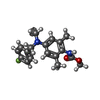+ Open data
Open data
- Basic information
Basic information
| Entry | Database: PDB / ID: 8izy | |||||||||||||||
|---|---|---|---|---|---|---|---|---|---|---|---|---|---|---|---|---|
| Title | Human KCNQ2-CaM in complex with HN37 | |||||||||||||||
 Components Components | Potassium voltage-gated channel subfamily KQT member 2 | |||||||||||||||
 Keywords Keywords |  MEMBRANE PROTEIN / MEMBRANE PROTEIN /  potassium voltage-gated channel / HN37 potassium voltage-gated channel / HN37 | |||||||||||||||
| Function / homology |  Function and homology information Function and homology informationaxon initial segment / Voltage gated Potassium channels /  node of Ranvier / Interaction between L1 and Ankyrins / node of Ranvier / Interaction between L1 and Ankyrins /  ankyrin binding / ankyrin binding /  voltage-gated potassium channel activity / voltage-gated potassium channel activity /  voltage-gated potassium channel complex / potassium ion transmembrane transport / voltage-gated potassium channel complex / potassium ion transmembrane transport /  nervous system development / chemical synaptic transmission ...axon initial segment / Voltage gated Potassium channels / nervous system development / chemical synaptic transmission ...axon initial segment / Voltage gated Potassium channels /  node of Ranvier / Interaction between L1 and Ankyrins / node of Ranvier / Interaction between L1 and Ankyrins /  ankyrin binding / ankyrin binding /  voltage-gated potassium channel activity / voltage-gated potassium channel activity /  voltage-gated potassium channel complex / potassium ion transmembrane transport / voltage-gated potassium channel complex / potassium ion transmembrane transport /  nervous system development / chemical synaptic transmission / nervous system development / chemical synaptic transmission /  calmodulin binding / calmodulin binding /  synapse / synapse /  plasma membrane plasma membraneSimilarity search - Function | |||||||||||||||
| Biological species |   Homo sapiens (human) Homo sapiens (human) | |||||||||||||||
| Method |  ELECTRON MICROSCOPY / ELECTRON MICROSCOPY /  single particle reconstruction / single particle reconstruction /  cryo EM / Resolution: 2.5 Å cryo EM / Resolution: 2.5 Å | |||||||||||||||
 Authors Authors | Ma, D. / Li, X. / Guo, J. | |||||||||||||||
| Funding support |  China, 4items China, 4items
| |||||||||||||||
 Citation Citation |  Journal: Nat Commun / Year: 2023 Journal: Nat Commun / Year: 2023Title: Ligand activation mechanisms of human KCNQ2 channel. Authors: Demin Ma / Yueming Zheng / Xiaoxiao Li / Xiaoyu Zhou / Zhenni Yang / Yan Zhang / Long Wang / Wenbo Zhang / Jiajia Fang / Guohua Zhao / Panpan Hou / Fajun Nan / Wei Yang / Nannan Su / ...Authors: Demin Ma / Yueming Zheng / Xiaoxiao Li / Xiaoyu Zhou / Zhenni Yang / Yan Zhang / Long Wang / Wenbo Zhang / Jiajia Fang / Guohua Zhao / Panpan Hou / Fajun Nan / Wei Yang / Nannan Su / Zhaobing Gao / Jiangtao Guo /  Abstract: The human voltage-gated potassium channel KCNQ2/KCNQ3 carries the neuronal M-current, which helps to stabilize the membrane potential. KCNQ2 can be activated by analgesics and antiepileptic drugs but ...The human voltage-gated potassium channel KCNQ2/KCNQ3 carries the neuronal M-current, which helps to stabilize the membrane potential. KCNQ2 can be activated by analgesics and antiepileptic drugs but their activation mechanisms remain unclear. Here we report cryo-electron microscopy (cryo-EM) structures of human KCNQ2-CaM in complex with three activators, namely the antiepileptic drug cannabidiol (CBD), the lipid phosphatidylinositol 4,5-bisphosphate (PIP), and HN37 (pynegabine), an antiepileptic drug in the clinical trial, in an either closed or open conformation. The activator-bound structures, along with electrophysiology analyses, reveal the binding modes of two CBD, one PIP, and two HN37 molecules in each KCNQ2 subunit, and elucidate their activation mechanisms on the KCNQ2 channel. These structures may guide the development of antiepileptic drugs and analgesics that target KCNQ2. | |||||||||||||||
| History |
|
- Structure visualization
Structure visualization
| Structure viewer | Molecule:  Molmil Molmil Jmol/JSmol Jmol/JSmol |
|---|
- Downloads & links
Downloads & links
- Download
Download
| PDBx/mmCIF format |  8izy.cif.gz 8izy.cif.gz | 419 KB | Display |  PDBx/mmCIF format PDBx/mmCIF format |
|---|---|---|---|---|
| PDB format |  pdb8izy.ent.gz pdb8izy.ent.gz | 340.9 KB | Display |  PDB format PDB format |
| PDBx/mmJSON format |  8izy.json.gz 8izy.json.gz | Tree view |  PDBx/mmJSON format PDBx/mmJSON format | |
| Others |  Other downloads Other downloads |
-Validation report
| Arichive directory |  https://data.pdbj.org/pub/pdb/validation_reports/iz/8izy https://data.pdbj.org/pub/pdb/validation_reports/iz/8izy ftp://data.pdbj.org/pub/pdb/validation_reports/iz/8izy ftp://data.pdbj.org/pub/pdb/validation_reports/iz/8izy | HTTPS FTP |
|---|
-Related structure data
| Related structure data |  35877MC 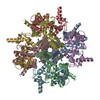 8j00C 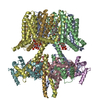 8j01C 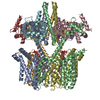 8j02C 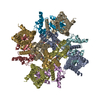 8j03C 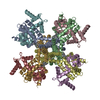 8j04C 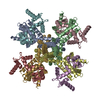 8j05C 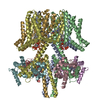 8w4uC M: map data used to model this data C: citing same article ( |
|---|---|
| Similar structure data | Similarity search - Function & homology  F&H Search F&H Search |
- Links
Links
- Assembly
Assembly
| Deposited unit | 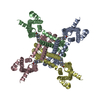
|
|---|---|
| 1 |
|
- Components
Components
| #1: Protein | Mass: 73627.812 Da / Num. of mol.: 4 Source method: isolated from a genetically manipulated source Source: (gene. exp.)   Homo sapiens (human) / Gene: KCNQ2 / Production host: Homo sapiens (human) / Gene: KCNQ2 / Production host:   Homo sapiens (human) / References: UniProt: O43526 Homo sapiens (human) / References: UniProt: O43526#2: Chemical | ChemComp-9MF / Has ligand of interest | Y | |
|---|
-Experimental details
-Experiment
| Experiment | Method:  ELECTRON MICROSCOPY ELECTRON MICROSCOPY |
|---|---|
| EM experiment | Aggregation state: PARTICLE / 3D reconstruction method:  single particle reconstruction single particle reconstruction |
- Sample preparation
Sample preparation
| Component | Name: human KCNQ2-CaM in complex with HN37 / Type: COMPLEX / Entity ID: #1 / Source: MULTIPLE SOURCES |
|---|---|
| Source (natural) | Organism:   Homo sapiens (human) Homo sapiens (human) |
| Source (recombinant) | Organism:   Homo sapiens (human) Homo sapiens (human) |
| Buffer solution | pH: 8 |
| Specimen | Embedding applied: NO / Shadowing applied: NO / Staining applied : NO / Vitrification applied : NO / Vitrification applied : YES : YES |
Vitrification | Cryogen name: ETHANE |
- Electron microscopy imaging
Electron microscopy imaging
| Experimental equipment |  Model: Titan Krios / Image courtesy: FEI Company |
|---|---|
| Microscopy | Model: FEI TITAN KRIOS |
| Electron gun | Electron source : :  FIELD EMISSION GUN / Accelerating voltage: 300 kV / Illumination mode: FLOOD BEAM FIELD EMISSION GUN / Accelerating voltage: 300 kV / Illumination mode: FLOOD BEAM |
| Electron lens | Mode: BRIGHT FIELD Bright-field microscopy / Nominal defocus max: 1300 nm / Nominal defocus min: 1100 nm Bright-field microscopy / Nominal defocus max: 1300 nm / Nominal defocus min: 1100 nm |
| Image recording | Electron dose: 64 e/Å2 / Film or detector model: GATAN K2 SUMMIT (4k x 4k) |
- Processing
Processing
CTF correction | Type: PHASE FLIPPING AND AMPLITUDE CORRECTION |
|---|---|
3D reconstruction | Resolution: 2.5 Å / Resolution method: FSC 0.143 CUT-OFF / Num. of particles: 367290 / Symmetry type: POINT |
 Movie
Movie Controller
Controller










 PDBj
PDBj
